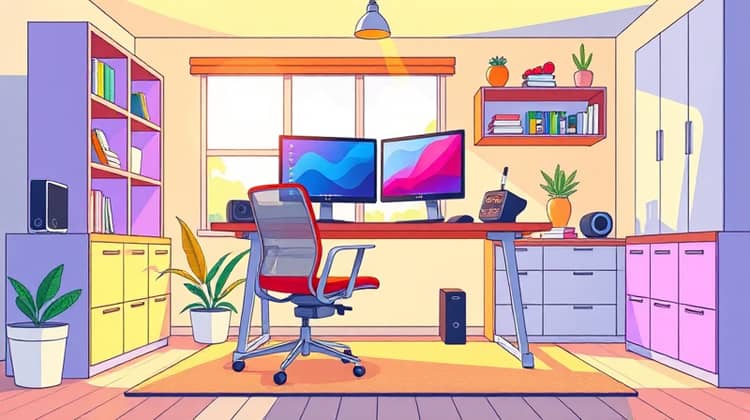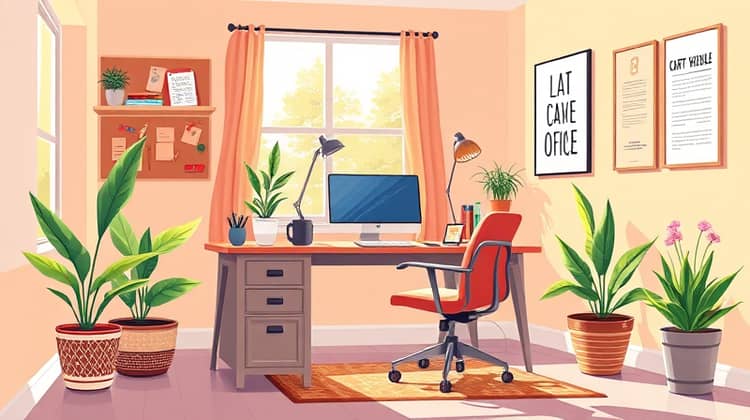As working from home becomes increasingly common, creating a productive home office setup is essential for maintaining focus and efficiency. A well-planned workspace not only boosts productivity but also enhances your overall working experience. Here are ten practical tips to help you design a home office that promotes productivity and comfort.
Your home office should be a space where you feel comfortable and driven to work. By implementing these tips, you can create an environment that minimizes distractions while maximizing your ability to achieve your goals. Let’s dive into the key elements of a successful home office setup that will help you thrive in your work-from-home journey.
Whether you’re a remote employee, a freelancer, or running your own business, a dedicated workspace can profoundly impact your motivation and performance. Every detail matters, from selecting the right location to maintaining cleanliness, so let’s explore how to optimize your home office together.
1. Choose the Right Location

Selecting the ideal location for your home office is the foundational step in creating a productive workspace. The right spot can influence everything from your focus and concentration to your overall work-life balance. Ideally, this space should be separate from high-traffic areas to minimize distractions.
When evaluating potential locations, consider factors such as natural light, available space, and noise levels. If possible, choose a room with a door that can be closed to create a boundary between work and personal life. This separation helps signal your brain that it’s time to work, improving concentration.
Additionally, think about the proximity of your workspace to essential resources like your printer, office supplies, and even your kitchen. The easier it is to access what you need, the less time you'll spend away from your desk, ensuring a more productive work session.
- A quiet room away from the hustle and bustle
- Good natural lighting for a bright ambiance
- Access to necessary resources and supplies
Remember that your home office shouldn't feel isolated. A well-chosen location allows for necessary interactions with family members or roommates while still providing a space where you can concentrate. Ultimately, a designated workspace will help you transition into work mode and stay focused on your tasks.
In summary, choosing the right location is crucial for a productive home office. A carefully selected area will support your work routine and significantly influence your efficiency.
2. Invest in Quality Furniture

One of the most impactful ways to improve your home office is to invest in quality furniture. Your desk and chair may seem like simple choices, but they play a significant role in your comfort and productivity. Durable, well-designed furniture can relieve strain and foster a healthier work habit.
Choose a desk that fits your needs, whether you prefer a large workspace for multiple monitors or a small desk that saves space. Pairing it with a comfortable chair that supports your posture will make all the difference, especially during long hours of work.
- An adjustable desk for versatility
- An ergonomic chair for comfort
- Storage furniture like shelves and cabinets
3. Prioritize Ergonomics

When working for extended periods, ergonomics becomes crucial in maintaining your health and productivity. Poor ergonomics can lead to discomfort, fatigue, and even long-term musculoskeletal issues. Therefore, ensuring your office setup promotes proper posture is essential.
To enhance ergonomics in your workspace, focus on the arrangement of your desk, chair, and equipment. Key elements include monitor height, keyboard placement, and even how frequently you take breaks.
- Adjust your chair height so that your feet rest flat on the floor.
- Position your monitor at eye level to avoid neck strain.
- Keep your keyboard and mouse close to your body to minimize reaching.
4. Optimize Lighting

Proper lighting can significantly improve your concentration and reduce eye strain. An office that is too dim can lead to headaches and fatigue, while overly bright spaces may create glare on your screen. Therefore, optimizing the lighting in your workspace is essential.
Consider natural light as your primary light source. Whenever possible, position your desk near a window. However, you should also supplement with soft and adjustable artificial lighting to avoid harsh shadows or glare from screens.
- Use desk lamps that provide adjustable brightness.
- Consider using window treatments to control direct sunlight.
- Introduce ambient lighting to create a balanced atmosphere.
5. Minimize Distractions

Distractions are often the nemesis of productivity. In a home office environment, it’s especially important to create a space that fosters focus and minimizes interruptions. Identify common distractions and seek ways to eliminate or reduce them during work hours.
Some distractions can be controlled by your workspace settings, while others may require personal discipline and boundaries with those you live with.
- Limit access to digital distractions like social media.
- Set boundaries with family or roommates during work hours.
- Create a ‘do not disturb’ signal when necessary.
6. Set Up Technology Efficiently

Technology is essential in today’s work environment, but it can also contribute to clutter and inefficiency if not organized properly. Consider the arrangement of your gadgets and ensure that everything is set up for optimal performance. Invest in charging stations or cable management systems to keep cords tidy and accessible.
Having a reliable internet connection, along with the necessary software and tools, will also enhance your productivity. It’s worth taking some time to assess your tech needs and make improvements where necessary.
- Invest in a fast internet connection
- Organize charging cables and accessories
- Utilize cloud-based tools for collaboration
7. Create a Functional Layout

The layout of your home office should serve your workflow, allowing you to move seamlessly from task to task without feeling congested. A well-planned layout will enable you to access everything you need without hindrance, boosting productivity and efficiency. Assessing how you work best can inform your layout choices.
Consider designating specific areas for different tasks, such as a reading nook, an area for phone calls, or a spot for brainstorming. However, make sure to avoid overcrowding your office with unnecessary furniture, which can lead to distractions instead of focus.
- Designate areas for specific tasks
- Keep frequently used items within reach
- Avoid clutter by organizing your workspace
8. Add Personal Touches

While functionality is critical, personalizing your workspace injects character and warmth into your home office. By surrounding yourself with items that inspire you, you create an environment that reflects your personality, enhancing your motivation and creativity during work hours.
Consider incorporating family photos, artwork, or motivational quotes that resonate with you. Personal touches not only brighten your mood but also create a more inviting and enjoyable workspace.
9. Plan for Storage

An organized workspace is key to productivity. Without a proper system for managing paperwork, supplies, and digital files, clutter can easily accumulate and create a stressful environment. Planning for storage effectively creates a sense of order and ensures that everything has a designated place.
Consider the types of storage solutions that work for your office size and layout. Incorporate filing cabinets, storage bins, and shelves to keep everything organized.
- Use filing cabinets for important documents
- Employ drawer organizers for small supplies
- Add shelves for books and office supplies
Investing in thoughtful storage solutions establishes an organized and functional workspace. A clean and tidy office not only promotes productivity but also streamlines your workflow.
10. Maintain a Clean and Organized Space

Cleaning your home office regularly is vital to maintaining a productive environment. A cluttered and dirty workspace can lead to distractions and hinder your overall performance. Establishing a cleaning routine will ensure that your office remains a welcoming space that you enjoy working in.
Take the time to declutter periodically and clean surfaces, both to promote hygiene and to foster a clear mind as you work.
- Vacuum or sweep the floor regularly
- Wipe down surfaces with disinfectant
- Clear off the desk at the end of each day
By keeping your office tidy, you'll create a more conducive atmosphere for creativity and efficiency. A clean workspace can help mentally reset you for the tasks ahead.
Conclusion

Creating a productive home office involves thoughtful planning and a commitment to maintaining an environment that supports your productivity. By following these ten tips, you can develop a workspace that meets your individual needs while promoting focus and efficiency.
Investing in your workspace not only enhances your productivity but also contributes to your overall satisfaction while working from home. Take the time to implement these strategies, and you'll be setting yourself up for success in your professional endeavors.














